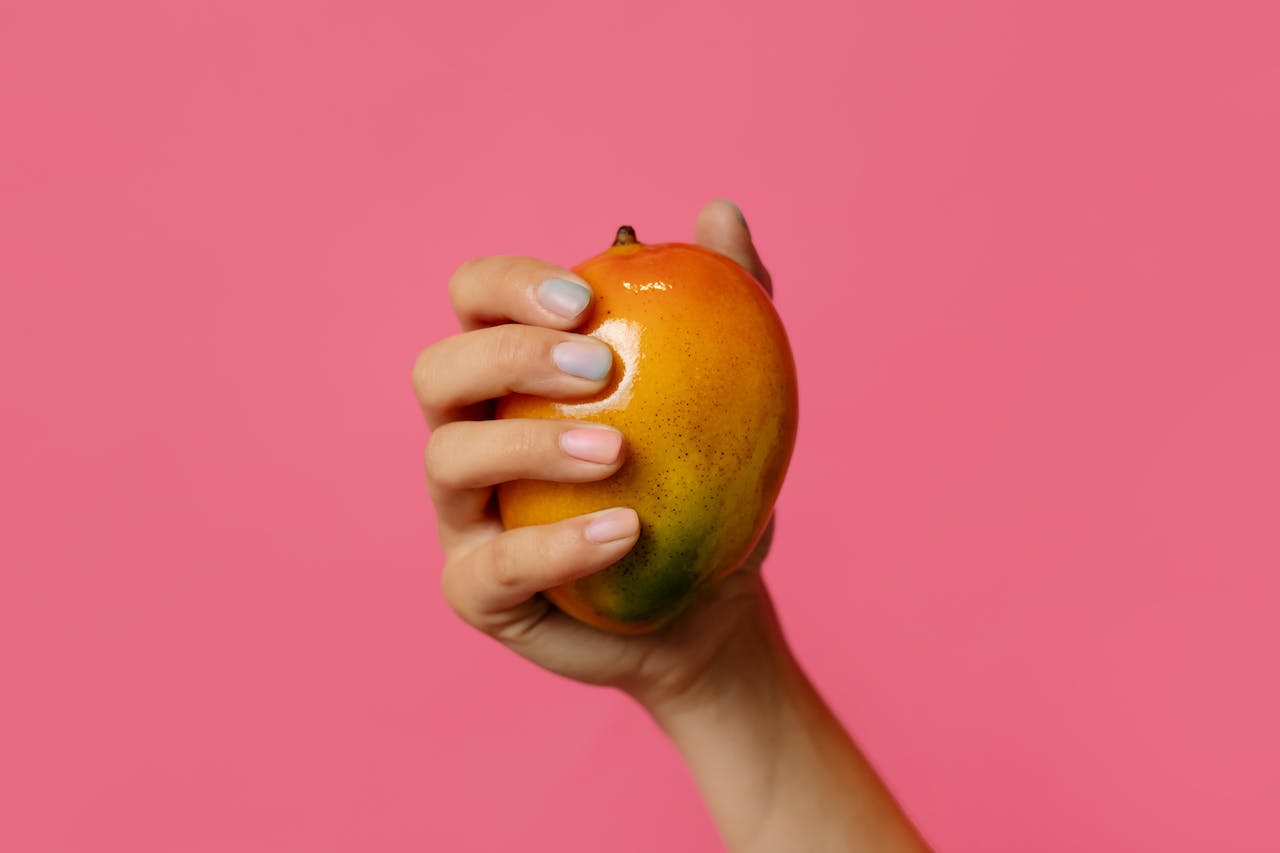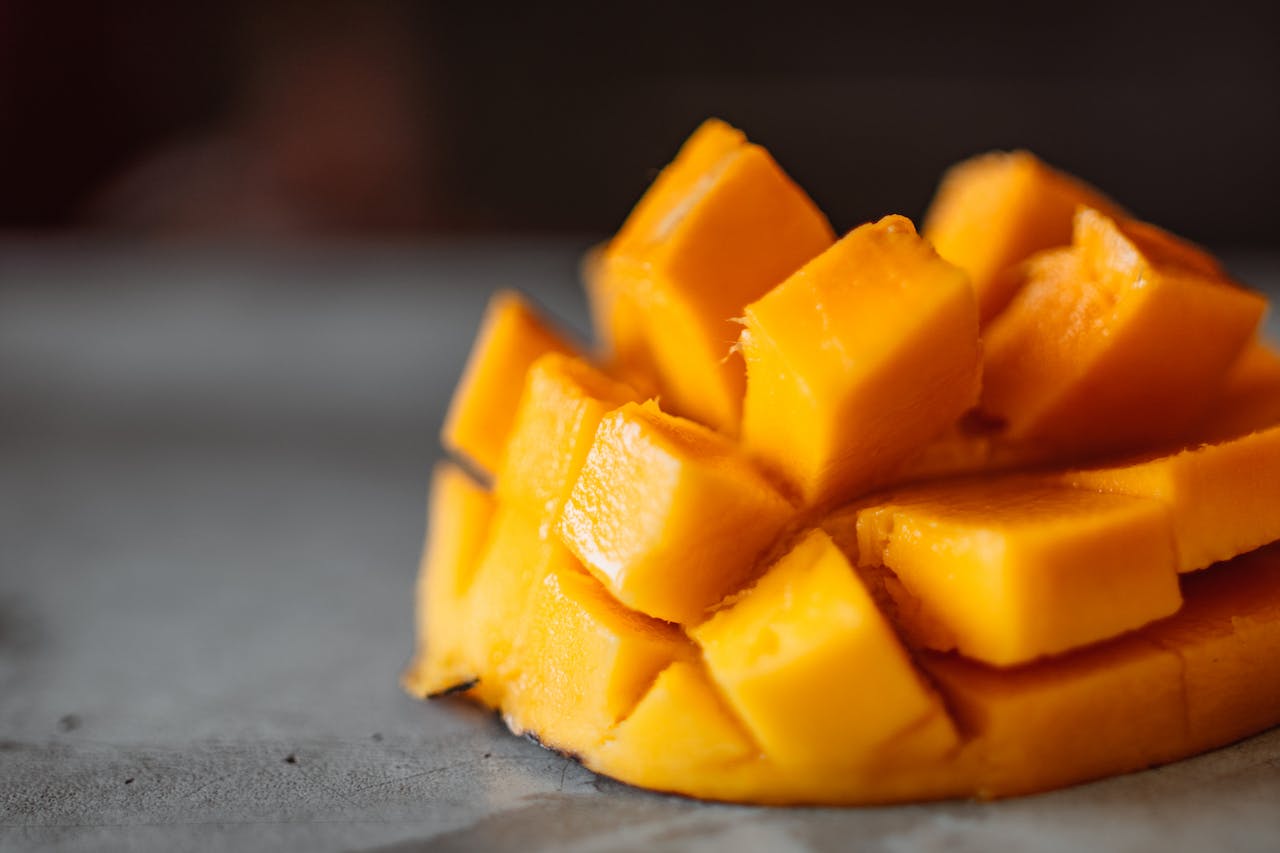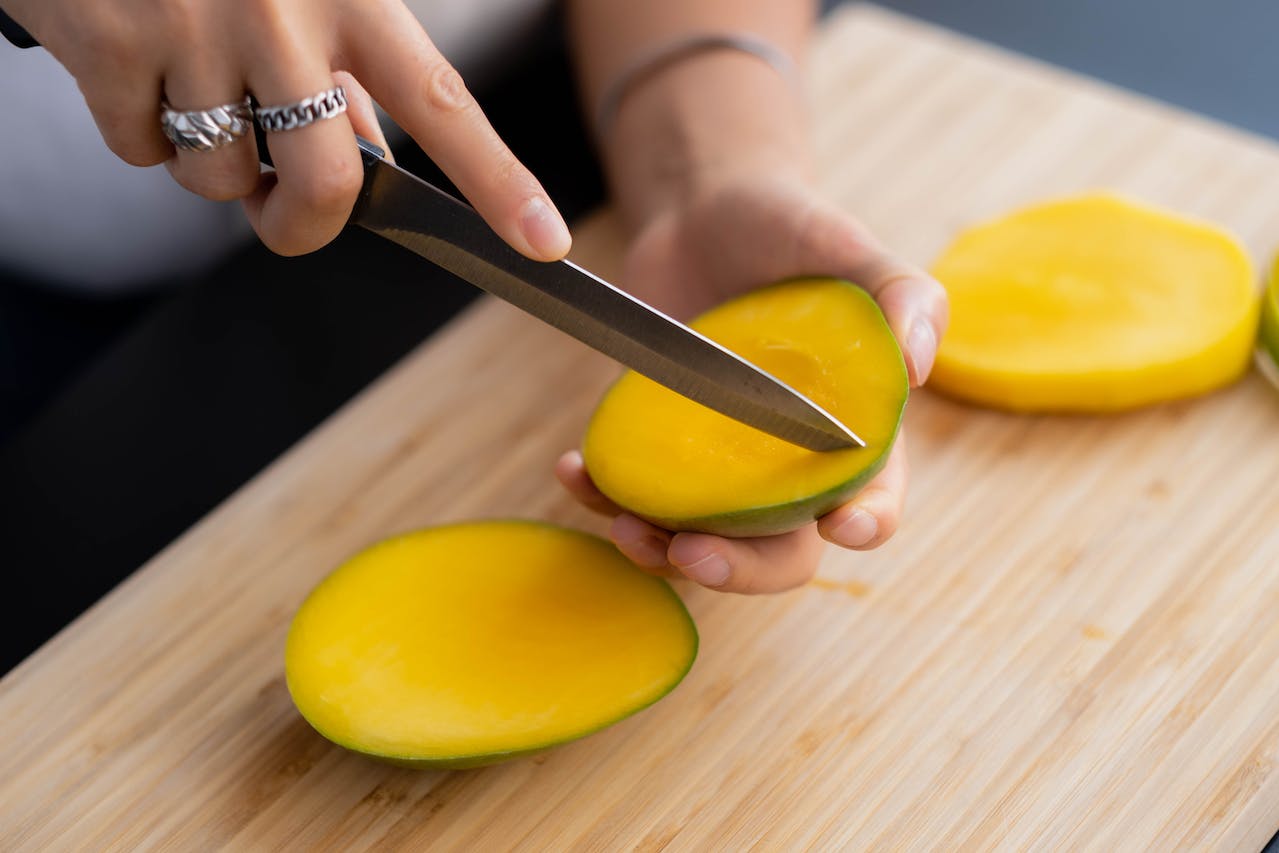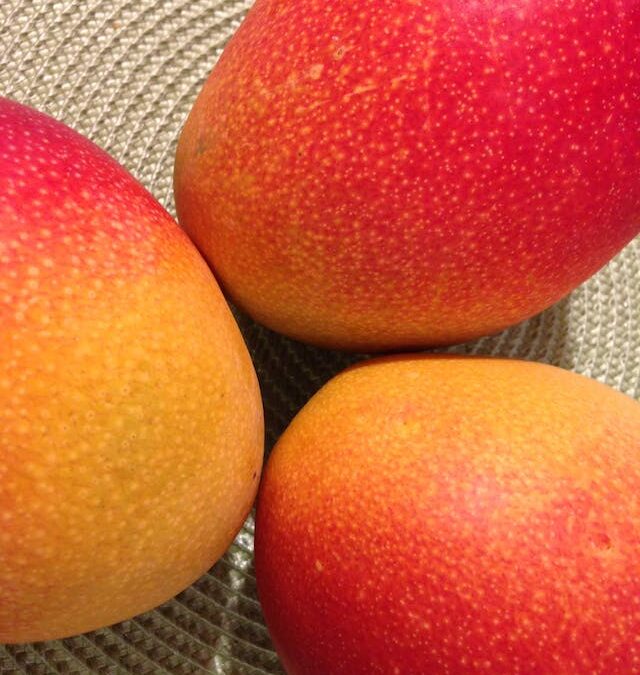Mangoes are one of the most popular fruits in the world and for good reason. They’re sweet, juicy, and delicious — but are they too delicious to be healthy? And how are they for the environment?
Read below the facts and myths about this delicious fruit.
Although it may not be as revered as the apple, banana, or even tomato (at least in the western world), the mango is one of the most commonly eaten fruits worldwide. And production has gone up around 17% in the last few years globally (1), averaging over 55 million mangoes per year.
This luscious, juicy, sweet fruit that has won fans the world over originated in India, where it has a long and revered history. One of the central rituals of Hinduism, the Puja ceremony, uses water infused with mango leaves (2) to create the proper resonance for honoured deities. Indian poets also use mangoes to evoke emotions like lust and love. And contemporary Indian novelists like Arundhati Roy and Anita Desai draw upon mangoes to symbolize abundance, sweetness, and possibility.
The mango is the national fruit of India (3), which produces more than half of all the mangoes consumed worldwide. Other top growers include Thailand, Mexico, and the tropical regions of China and the US.
With billions of fans and centuries of great PR, you’d think that mangoes have it made. But due to their high sugar content, mangoes are often vilified by low-carb enthusiasts. And because they’re exported around the globe, some environmentalists express concern over their carbon footprint and sustainability.
So are mangoes good for you, and the planet? Can we enjoy them without worrying about our health or their environmental impact? And, just as controversial, is the plural form of mango spelled “mangos” or “mangoes”?
Types of Mangoes
Mangoes are a stone fruit, like peaches, plums, and cherries. The official biological name for such a fruit is a drupe, which might come in handy in a tight game of Scrabble. 😂 The mango tree, whose botanical name is Mangifera Indica, is part of a pretty intense family, the Anacardiaceae. Other members include cashews and sumac, along with poison ivy and poison oak! All these plants can cause allergic reactions in humans, thanks to the oily compound urushiol found in their sap.
Mangoes come in a variety of types and colors, and their taste varies depending on variety as well as the degree of ripeness. Typically, mangoes are sweet and juicy, with varying degrees of tartness. Some folks describe their flavour (4) as similar to those of peach, pineapple, and apricot, although as someone who’s eaten plenty of all these fruits, there’s no way to compare one to another. Some things just don’t translate into words, and the taste of a ripe mango is one of them.
While there are over 1,000 varieties of mango growing worldwide, we see six main types (5) in the grocery stores. And given the mango’s storied pedigree, the names are pretty bland: Honey (also known as Ataulfo), Francis, Haden, Keitt, Kent, etc.
In Indonesia Mangga Harum Manis is the most popular and in Singapore – Manila Mango
Other varieties that pop up from time to time include Alphonse, Edward, Kesar, and Palmer.

Mango Nutrition
Like most whole plant foods, mangoes are nutrient-dense. They’re high in many vitamins, especially A, C, and B6. And they contain a small amount of protein, as well as some copper and potassium. Their heightened sweetness indicates that mangoes are high in calories and carbohydrates (which is why our ancestors’ preference for sweets, which most of us have inherited, was such an important survival mechanism).
With all those natural sugars, you might think they’re a no-no for people with diabetes, or anyone wanting to avoid spiking their blood sugar. But raw mango ends up mid-range on the glycemic index (51 out of 100) because of its high fibre content (6). In fact, one cup of raw mango provides three grams of fibre, which fulfils 12% of the recommended daily intake.
Benefits of Mangoes
So are mangoes good for you, then? Researchers are discovering more and more health benefits of mangoes all the time. Both in laboratory assays and in clinical trials, mangoes are dazzling scientists with the breadth of their positive impacts.
Anti-inflammatory
For one thing, mangoes appear to be highly anti-inflammatory. In a study (ethically disturbing?), mice who were given an ulcerative colitis experienced showed improvement in symptoms when given extracts of the mango fruit itself (7), as well as a compound found in the tree’s stem bark.
Other studies found that enzymes in the fruit were protective against ulcers in both mice and rats. Given how many humans already suffer from these conditions, and that rodent trials don’t always correlate to human results, it sure would be advantageous if we conducted clinical trials with people eating actual mangoes. We’d reduce animal suffering and possibly human suffering as well.

High in Antioxidants
Mangoes contain high concentrations of both ascorbic acid (vitamin C) and various polyphenols, which are phytonutrients — nutrients found in plants — that have a host of positive effects. One such polyphenol specific to mangoes is mangiferin (8), which helps reduce iron overload (again, in rats and mice), and could be a useful addition to the diets of people with hemochromatosis (a condition that often produces excessive iron in the blood).
Other antioxidant compounds found in mangoes may prevent oxidative stress (think of rusting, inside your body), and may actually repair oxidative damage related to ageing, cancer, atherosclerosis, heart attack, stroke, and diabetes.
Anticancer Properties
Mangoes may have powerful anticancer effects (9) on tumour cells. Now we move from the world of animal studies to the test tube, where cancer cells and potential anticancer compounds fight it out under the bright glare of science. In these contests, mango extracts keep coming out on top.
A team from Texas found that compounds found in mangoes killed tumour cells in multiple types of cancer, including pancreatic, cervical, colorectal, and breast (10). Notably, the compounds triggered apoptosis (cell death) in the cancer cells, but not in healthy human cells. One caveat: the studies were all funded by the National Mango Board, which doesn’t negate the results, but suggests that the studies need to be replicated by researchers without any potential conflicts of interest.
Diabetes Treatment & Prevention
You might expect mango to wreak havoc with the blood glucose of someone suffering from diabetes because of its high sugar content. It turns out that, in rat studies(11), mango consumption actually decreases blood glucose levels. This puts the fruit in the same category as a bunch of anti-diabetic drugs. But in the case of the mango, the blood sugar heroes appear to be the polyphenols, carotenoids (another family of phytonutrients found in orange-hued plants), and high fibre content.
Not everyone reacts the same way to particular foods, so you’ll want to see for yourself the effects of mango consumption on your blood sugar if that’s a concern. Start by sticking to a single serving. And if you have a condition that requires blood sugar monitoring, test your blood sugar after eating to see how your body responds. Keep in mind that mango juice may have a different effect than eating whole fruit pieces. When fruits are pulverized and their fiber is removed, the absorption of sugars happens much quicker.
What about dried mango? Any time you try dried fruit, you’re removing most of the water from it, which concentrates both the nutrients and the sugars. As such, unsweetened dried mangoes (13) are an even richer source of fibre and antioxidants — and they can also taste even sweeter. In general, their glycemic load is considered similar to that of fresh mangoes although some researchers say it might be a bit higher.
Some dried mango also comes with added sugar. In my opinion, it ceases to be a healthy food and becomes more of a candy.
May Protect Your Skin
The mango might help protect you from UV radiation damage caused by the sun. What we know, thanks to a 2013 study out of an anti-ageing laboratory in Korea, is that mango extract reduced and to some extent reversed the effects of UVB radiation on a group of hairless mice (14).
Risks of Eating Mangoes
One very convincing reason of the risks is if eating a mango gives you a case of an oral allergy syndrome (15).
This condition is characterised by itching and swelling of the mouth, lips, and throat, accompanied by skin reactions, asthma, and rhinitis (inflammation of the mucous membranes of the nose). If things really get bad, the syndrome can include cardiovascular symptoms and anaphylaxis. So if you or someone you know experiences any of those symptoms following eating or touching a mango, seek medical attention right away.
And remember how mangoes are related to poison ivy and poison oak? Well, they have more in common than just an ancient ancestor. The sap, leaves, and bark of the mango tree, and in some cases the skin of the fruit, can produce the same blistering skin rash in susceptible individuals (16). If you know you respond badly to poison ivy, you might want to go slow with adding mangoes to your diet, until you know they don’t cause an allergic reaction — and also to handle mango skin with caution.
Pesticides
The Environmental Working Group, which rates produce in terms of pesticide exposure, places mangoes in the middle of the pack (specifically, mangoes are the 31st most pesticide laden produce (17) of all the ones EWG includes in their ratings). They aren’t featured in either the Dirty Dozen or the Clean 15. Compared to other produce, mangoes are comparatively low in pesticides. On the other hand, researchers from the USDA Pesticide Data Program (18) did detect 11 distinctively different pesticides in mangoes. That’s a good reason to peel mangoes before eating and to choose organic if possible.
Are Mangoes Sustainable?
Unless you live in the tropics, the mangoes available at your local grocery store or market are imported from somewhere else. For those of us who try to eat more local foods to reduce the carbon footprint of our diets associated with the transport of distant foods, that might disqualify mangoes as an everyday fruit.
The US National Mango Board commissioned a sustainability assessment (19) in 2017 and determined that the greenhouse gas emissions from mangoes were similar to those from other imported fruits and vegetables. Most of these emissions arose from two sources: agrochemicals (including fertilizers) and transport. If you go with organic mangoes, then far fewer agrochemicals will be used, which naturally reduces the environmental impact.
However, unlike many fresh produce, mangoes come from trees. And mango orchards help compensate for the greenhouse gas emissions generated through the production and distribution of the fruit through carbon sequestration. (20)
Water & Labour Conditions
Where mango trees lose their sustainability edge is in their relatively high water requirements. (21) Mangoes use, on average, 1,000 liters of water for every kilogram of fruit produced. Many other crops use less: oranges require 330 liters/kg, watermelons need 378 liters/kg, and tomatoes only 64 liters/kg.
But there may be a fix for this problem. In India, some mango farmers have adopted what’s known as the ultra high density planting method (22), which can increase the productivity of trees 2-3 times, reduce water requirements by up to 50%, and increase fertiliser intake, which means less watering is necessary (and thus, less CO2 is released).
Another potential concern with mangoes is agricultural labor conditions. Simply put, many tropical fruits and vegetables come from countries that don’t have great labor regulations. And when farmers are paid rock bottom prices in a competitive marketplace, they may not have the means to pay their workers fairly. If you are able to buy organically grown and fair-trade certified mangoes, you help to ensure that farmworkers aren’t exposed to pesticides on the job and that the people who grew your food were paid enough to live with a degree of dignity.
Enjoy Mangoes
Mangoes are well-loved fruit, and they’re a rich source of fibre and antioxidants. Although they’re high in sugar, in their whole food form, they can still be an excellent part of a well-balanced diet and are, in fact, good for you! You can use and prepare mangoes in many fun and nutritious ways. Although there are some health risks and environmental considerations regarding mangoes, the benefits mostly outweigh the risks. And if possible, go for fair-trade and organic mangoes to reduce possible negative impacts on farmworkers and the environment.
Oh, and about that “mangoes” vs “mangos” question: the answer is — the experts have no consensus, so you get to choose whichever option you like. Some words that end in “o” get an “e” added to the plural (heroes, potatoes), and some don’t (photos, egos). If you’re writing a term paper about the fruit, and you want to fill more pages, add the “e.” If you’re trying to compose a mango-centric Tweet and nearing your character limit, leave it out. It’s totally your call. ENJOY!

Mango-licious Recipes
Sambal mangga (Mango chilli chutney) is one of Indonesia’s most popular chilli sauces. The sourness and freshness of the young mango combines with the spiciness of the chilli to give this sambal a distinct flavour, while garlic and shrimp paste enhance the experience.
Categories: Sauce
Cuisine: Indonesian
Ingredients: Fruit
Prep Time: 20 mins
Cook Time: 10 mins
Total Time: 30 mins
Serves: 1/2 cup
Ingredients
2 tablespoon oil
2 teaspoon coconut sugar
1 teaspoon salt
100 gram slightly underripe mango flesh, cut into matchsticks
juice of 1 lime, or to taste
Grind the following into coarse paste
8 red cayenne chilies
3 to 8 red bird eye chilies
1 teaspoon toasted shrimp paste – omit for vegetarian option
Instructions
Heat oil in a frying pan, then sauté chili paste until fragrant, about 5 minutes.
Season with coconut sugar and salt, adjust taste as needed.
Turn off heat, transfer the chili sauce to a mixing bowl, then add the mango and gently toss until well mixed. Add lime juice as needed. Serve immediately.
Thai Sweet Sticky Rice With Mango (Khao Neeo Mamuang)
This mango sticky rice is a wonderful and authentic-tasting Thai dessert
Prep Time: 10 mins
Cook Time: 20 mins
Additional Time: 1 hr
Total Time: 1hr 30 mins
Servings: 4
Yield: 3 cups
Ingredients
2 cups water
1 ½ cups uncooked short-grain white rice
2 cups coconut milk, divided
½ cup of honey
¾ teaspoon salt, divided
1 tablespoon honey
1 tablespoon tapioca starch
3 mangoes, peeled and sliced
1 tablespoon toasted sesame seeds
Directions
Combine water and rice in a saucepan. Bring to a boil, cover, and reduce heat to low. Simmer until water is absorbed, 15 to 20 minutes.
While the rice cooks, combine 1 1/2 cups coconut milk, 1/2 cup honey, and 1/2 teaspoon salt in another saucepan. Bring to a boil over medium heat; remove from the heat and set aside.
Stir cooked rice into coconut milk mixture. Cover and allow to cool for 1 hour.
Make a sauce by combining 1/2 cup coconut milk, 1 tablespoon honey, 1/4 teaspoon salt, and tapioca starch in another saucepan; bring to a boil.
Place coconut rice on a serving dish and arrange mangos on top. Pour sauce over mangos and rice. Sprinkle with sesame seeds.
References:
(1) ao.org/faostat/en/#data/QC/visualize
(2) https://www.hindujagruti.org/hinduism/knowledge/article/why-are-mango-leaves-kept-in-the-kalash-during-puja-ritual.html#41
(3) https://www.forbesindia.com/article/independence-day-special/national-fruit-mango/38445/1
(4) https://www.adv-bio.com/light-sweet-tropical-flavor-mango
(5) https://www.cs.mcgill.ca/~rwest/wikispeedia/wpcd/wp/m/Mango.htm
(6) https://glycemicindex.com/gi-search/
food_name=mango&product_category=&country=&gi=&gi_filter=&serving_size_(g)=&serving_size_(g)_filter=&carbs_per_serve_(g)=&carbs_per_serve_(g)_filter=&gl=&gl_filter=
(7) https://www.ncbi.nlm.nih.gov/pmc/articles/PMC5452255/
(8) https://pubmed.ncbi.nlm.nih.gov/30189460/
(9) https://www.tandfonline.com/doi/abs/10.1080/10408398.2020.1771678?journalCode=bfsn20
(10) https://www.sciencedaily.com/releases/2010/01/100111154926.htm
(11) https://www.sciencedirect.com/science/article/abs/pii/S1756464617304462
(12) https://www.healthline.com/nutrition/mango-is-5)good-for-diabetes#nutrients
(13) https://www.webmd.com/diet/dried-mango-is-it-good-for-you
(14) https://pubmed.ncbi.nlm.nih.gov/23458392/
(15) http://research.bmh.manchester.ac.uk/informall/allergenic-food/?FoodId=34
(16) https://www.ncbi.nlm.nih.gov/pmc/articles/PMC2763731/
(17) https://www.ewg.org/foodnews/full-list.php
(18) https://www.whatsonmyfood.org/food.jsp?food=MA
(19) https://www.mango.org/wp-content/uploads/2017/10/Sustainability_Exec_Summary_Eng.pdf
(20) https://www.newindianexpress.com/good-news/2019/dec/23/mangoes-sweet-for-environment-too-says-study-2079823.html
(21) https://www.mango.org/wp-content/uploads/2017/10/Sustainability_Exec_Summary_Eng.pdf
(22) https://www.thebetterindia.com/252647/mango-farm-ultra-high-density-planting-uhdp-kesar-alphonso-profits-farmer-success-story/
To your health and happiness,
Jane

